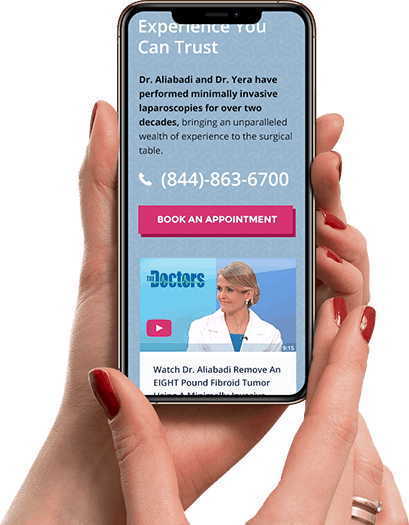A hysterectomy, or surgical removal of the uterus, is one of the most common procedures within obstetrics and gynecology. Across the United States, 600,000 women undergo a hysterectomy every year.
But don’t mistake their popularity for triviality: hysterectomies are a major surgery with lifelong effects on women’s health. Hysterectomy recovery usually takes time — anywhere between two weeks and two months. And as much as we often want to “get back on the horse” and leave the surgery behind, sometimes slow and steady will get you back to your old self sooner.

What is a hysterectomy?
A hysterectomy is a type of surgery used to remove part or all of the uterus and sometimes its accompanying organs. Gynecologists may recommend a hysterectomy to:
- Remove a tumor in the uterus, ovaries, or cervix, especially if it’s cancerous.
- Provide relief from severe endometriosis, which often causes pelvic pain or prolonged vaginal bleeding.
- Remove uterine fibroids, cysts, or adhesions.
- Prevent future cancer in people at an extremely high risk of it (such as patients who test positive for the BRCA1 or BRCA2 genes).
- Treat conditions such as uterine hyperplasia, adenomyosis, or uterine prolapse.
We usually classify hysterectomies depending on the organs removed or the technique used. When looking at the organs removed, hysterectomies can be:
- Partial or supracervical hysterectomies — just remove part of the uterus and leave all other pelvic organs intact.
- Total — takes out the entire uterus and the cervix. Total hysterectomies are sometimes done alongside an oophorectomy (removal of the ovaries), a salpingectomy (removal of the fallopian tubes), or both.
- Radical hysterectomy — also removes the surrounding tissue and the upper part of the vagina.
Your doctor will recommend the best type of hysterectomy for your situation, taking into account your personal history, age, and other risk factors. As a general rule, it’s best to remove only what’s strictly necessary.
How is a hysterectomy performed?
Once we’ve decided on the proper type of hysterectomy for your situation, we have multiple surgical options.
Open abdominal hysterectomies
This is the oldest and most invasive method for hysterectomies, yet it remains the most popular. During an open hysterectomy, a surgeon will do a large cut on the lower abdomen. Then, they will use this opening to take out the uterus or surrounding organs. As this cut is usually around 7 inches long, open hysterectomies require the longest and most uncomfortable recovery times.
Vaginal hysterectomies
This type of hysterectomy involves a much smaller cut just on top of the vagina. Through this incision, a surgeon can detach the uterus, ovaries, and tubes from the surrounding organs. Then, the uterus can be “pulled out” through the vagina.
Sometimes, vaginal hysterectomies are done with the help of a laparoscopic camera. A laparoscopically assisted vaginal hysterectomy (LAVH) requires a second “keyhole” incision through the abdomen but allows for much more precise cuts. It can also help if we need to take a look at the surrounding organs.
Laparoscopic hysterectomies
This minimally invasive procedure allows you to remove a uterus using only small “keyhole” incisions. With much smaller cuts, we also get faster recovery, a lower chance of infection, and less pain. Laparoscopic techniques have advanced significantly over the past few years.

Call 877-760-3564 or click here to schedule online
Hysterectomy recovery week by week
Recovering from a hysterectomy will depend greatly on the procedure you underwent. Generally, laparoscopic hysterectomy recovery is much faster than that from a vaginal or open hysterectomy. Overall, where you may need up to two months to bounce back fully from an open hysterectomy, the small incisions from a laparoscopic procedure will mostly be healed in three weeks to a month.
However, recovering from any of these procedures will largely follow the same pattern.
The immediate aftermath
After waking up from the anesthesia, the main side effects you’ll experience will be grogginess, nausea, and pain.
If you had an abdominal or open procedure, you would stay at the hospital for three to five days. During some of this time, you may also need to use a urinary catheter, as you won’t be able to pass urine normally. Sometimes, you may also need a small drainage tube to remove any blood from beneath the incision. Both the tube and the catheter will be removed before you go home.
After a vaginal procedure, you may only need one or two nights in the hospital — while a laparoscopic procedure may not need an overnight stay at all. You’ll be sent home with clean dressings and some painkillers and will already be walking — even if just a few steps at a time.
The first few days at home
When you first return home, you can expect your cut to feel sore or swollen. This may turn painful when coughing, laughing, or bending. You will also need to keep a light or bland diet until your bowel movements return to their usual rhythm. You can expect to feel very tired and eager to sleep all day: this is normal, as your body needs extra energy to heal itself back up. In addition, you will probably still be taking milder pain medications.
If you had an open procedure, this stage could last up to a week — or at least until you return to the doctor to remove your stitches. This may go away in three to five days for a laparoscopic procedure.
At this stage, your priority should be to keep your dressings dry and clean, as there’s still some risk of infection. You should also try to walk around your house several times a day. There’s no need to be quick or work up a sweat: the goal is not to exercise but to get your body moving to prevent blood clots and constipation.
The long road ahead
Your ability to move around will increase exponentially after the first few days at home. However, you will likely continue to feel out of sorts, as if your general “energy reserve” just hasn’t filled back up. This is because your cuts are still healing inside, even if the skin already looks “closed.”
You will still need to avoid strenuous exercise, especially heavy lifting, for a few more weeks (a month for laparoscopic surgery or two more months for open surgery). You may also need to wait a couple of weeks before sexual intercourse.
This stage of recovery will vary the most. It’s best to check with your doctor before you resume any new physical activity — from yoga to gym workouts to sex.
What happens if you rush your hysterectomy recovery?
Few of us would look forward to spending one or two months “closed for business” or experiencing constant pain. And yet, trying to rush your recovery process may accidentally prolong it. If you push yourself beyond what you’re ready to do, you will increase your risk of accidental tears or push yourself into renewed fatigue.
In addition, the impact of a hysterectomy goes beyond the physical effects of your incisions. Hysterectomies can also leave a psychological toll behind. Finally, the lifelong hormonal changes they produce may worsen your physical and mental fatigue.
Dealing with the physical aftermath of a hysterectomy
Even after beating the hardest initial days after your surgery, hysterectomies often leave several pervasive symptoms. These include:
- chronic fatigue
- problems with your sleep
- pain when bending or standing up too quickly
- digestive issues, such as an easily upset stomach
- difficulty passing stool
Despite your eagerness to resume normal activities, these symptoms are your body’s way of telling you that work is still to do. Pay extra attention to any pain, especially related to physical activity. If you feel any pressure or a burning feeling near your incision, you’re likely not ready for that kind of exercise yet.

You will also need to watch your diet carefully during recovery. Your body will need extra nutrients, especially proteins and vitamins, as it repairs itself. Constipation is common after abdominal surgery, as the swelling will keep your bowels from moving. However, it’s best not to take any laxatives past the first two days after the surgery. Instead, try to eat more fiber-rich foods.
Your recovery timeline will also be affected by the reason for your hysterectomy. In cases of endometriosis or fibroids, you may be looking forward to living a new life free of period pain or heavy bleeding. However, if you have been diagnosed with cancer or suspect a cancerous growth, a hysterectomy will only be the first part of a much longer treatment.
What hormonal changes can you expect after a hysterectomy?
If you had a total or radical hysterectomy, or if they also removed your ovaries alongside your uterus, then you’ll most likely experience some hormonal changes too. This is because the ovaries and reproductive organs produce most of your estrogen and progesterone.
In some cases, this may cause you to go through menopause immediately. In other cases, your hormone levels may dive, but you will still have periods. Either way, the lack of hormones may cause hot flashes, mood swings, or problems with your sexual function, such as vaginal dryness. These symptoms may mix poorly with your generalized fatigue and keep you out of sorts for longer.
The good news? There’s treatment. A frank talk with your gynecologist can help you find a form of Hormonal Replacement Therapy (HRT) that is safe and sustainable for you.
Adjusting mentally to a hysterectomy
Finally, we need to talk about the psychological effects of a hysterectomy. These vary greatly from person to person. In many cases, having a hysterectomy is usually accompanied by a deep sense of loss. This can be caused why:
- The pain and feeling of frailness during recovery.
- Hormonal mood swings or depression.
- Anxiety about the results of the surgery or an upcoming biopsy.
- The perceived loss of femininity or sexuality, especially for radical hysterectomies.
- The loss of fertility, especially if you plan to have children later on.
The Outpatient Hysterectomy Center: A state-of-the-art option for laparoscopic hysterectomies in LA
The Outpatient Hysterectomy Center is run by two of California’s best-ranked gynecological surgeons, Dr. Thais Aliabadi and Dr. Ramon Yera. Thanks to their extensive training and well-rounded team, they offer safe, less invasive, and faster hysterectomies for women from all walks of life.
We invite you to establish care with the Outpatient Hysterectomy Center. Please make an appointment online or call us at (844) 863-6700.
The Outpatient Hysterectomy Center is conveniently located for patients throughout Southern California and the Los Angeles area. At the Cedars-Sinai Medical Center, we are near Beverly Hills, West Hollywood, Santa Monica, West Los Angeles, Culver City, Hollywood, Venice, Marina del Rey, Malibu, Manhattan Beach, and Downtown Los Angeles.
Call 877-760-3564 or click here to schedule online










